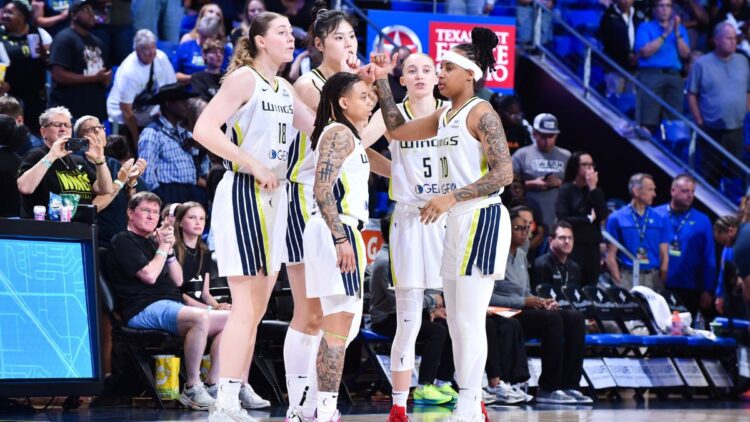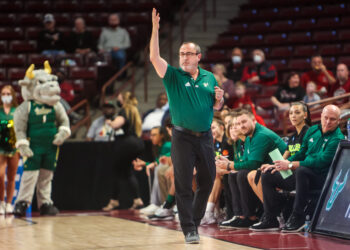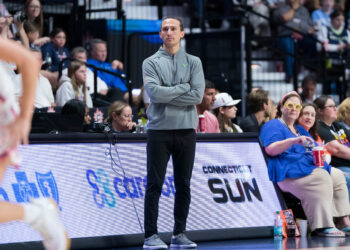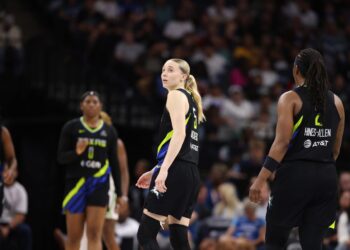That promise was on display in Thursday’s 98-89 win over the Phoenix Mercury, where all four of the Wings’ primary frontcourt players — Teaira McCowan, Luisa Geiselsöder, Myisha Hines-Allen and Li Yueru — played significant roles. Following the returns of McCowan and Geiselsöder from EuroBasket, it was the first time all four had been available and used together in a single game.
Saturday’s practice at College Park Center was a benchmark moment. All four of the team’s primary frontcourt players practiced together, building live-rep chemistry that had previously been out of reach. Until now, head coach Chris Koclanes has had to improvise with just one or two traditional bigs available at a time.
Your business can reach over 3 million women’s sports fans every single month!
Here at The Next and The IX, our audience is a collection of the smartest, most passionate women’s sports fans in the world. If your business has a mission to serve these fans, reach out to our team at editors@thenexthoops.com to discuss ways to work together.
‘Post Army’ identity taking shape
Against Phoenix, Yueru and Geiselsöder started together for the first time and played a key role in establishing early physicality. Yueru had a double-double with 12 points and 11 rebounds, while Geiselsöder chipped in four points, four rebounds, and three blocks. Their presence in the paint set the tone defensively, while they did the little things offensively to make it easier for guards like Paige Bueckers, Aziaha James and JJ Quinerly, who combined for 68 points and 18 assists.
McCowan anchored the second unit and posted nine points and five rebounds in under 17 minutes. Her presence in drop coverage helped contain Phoenix’s downhill attacks, while finishing around the rim extended Dallas’ lead in the third quarter.
Hines-Allen added five points and five rebounds off the bench and toggled between power forward and being a small forward in jumbo lineups. Dallas briefly practiced those bigger combinations earlier in the week out of necessity, with many perimeter players sidelined.
Your business can reach over 3 million women’s sports fans every single month!
Here at The Next and The IX, our audience is a collection of the smartest, most passionate women’s sports fans in the world. If your business has a mission to serve these fans, reach out to our team at editors@thenexthoops.com to discuss ways to work together.
Koclanes has dubbed the frontcourt group a “post army,” praising their collective ability to screen, rebound, and protect the paint.
“We can finish better — be stronger with the ball, keep it high, finish through the square,” Koclanes said. “But I love the presence we have in the paint. No matter the combination, I love what we can do around the rim.”
One of his key messages to Yueru has been about sprinting the floor and establishing a deep position in the paint early in possessions, keeping her role simple, direct, and aggressive.
“Before the game, Coach Chris told us: one post runs fast, the other takes the sideline inbound,” Yueru said. “That gave us a clear role. I didn’t have to think too much — just run, post up, and make the read. I felt really comfortable in that role, and I think we’ll keep doing it.”
Hines-Allen and McCowan round out the rotation with distinct stylistic differences. Hines-Allen thrives as a face-up player and connective passer, especially in the short roll. McCowan brings a power post presence and interior defense, anchoring the Wings in drop coverage.
“Myisha is more of a pocket playmaker — she can catch and attack downhill,” Koclanes said. “And Teaira, even though she’s more of a long roll option, has more touch and handle than people realize.”
Save 30% when you order “Becoming Caitlin Clark”
Howard Megdal’s newest book is here! “Becoming Caitlin Clark: The Unknown Origin Story of a Modern Basketball Superstar” captures both the historic nature of Clark’s rise and the critical context over the previous century that helped make it possible, including interviews with Clark, Lisa Bluder (who also wrote the foreword), C. Vivian Stringer, Jan Jensen, Molly Kazmer and many others.
Click the link below to order and enter MEGDAL30 at checkout.
Defense and communication are still progressing
The infusion of size has made a noticeable impact defensively, especially in Dallas’ ability to stay home in pick-and-roll coverage and rotate with more length. Koclanes noted the value of having multiple bigs who can move their feet and protect space without constant switching.
“You have a couple of bigs now that can really move their feet as well,” he said. “Just both of them, yeah, with their defensive mobility. I think they’re two good pieces to invest in and build with.”
Geiselsöder has looked comfortable switching onto guards and defending out in space. McCowan, in contrast, has continued to play drop and clean up the glass. Yueru still finds her timing and communication in team schemes, but her size and instincts are hard to miss.
“Defensively, she’s a big presence — it’s going to be hard for opponents to score over her,” Geiselsöder said. “So it definitely helps.”
Yueru agreed that communication is still a work in progress for the group, especially in fast-break scenarios where matchups shift quickly.
“It was our first game starting together, and sometimes we were still trying to figure things out on the court,” she said. “We weren’t always clear with each other, yet. We’re still learning.”
The Next, a 24/7/365 women’s basketball newsroom
The Next: A basketball newsroom brought to you by The IX. 24/7/365 women’s basketball coverage, written, edited and photographed by our young, diverse staff and dedicated to breaking news, analysis, historical deep dives and projections about the game we love.
Ripple effects on the guards
While one of the key stories concerns the frontcourt, the ripple effects are evident across the roster. Quinerly and James credited the bigs with creating space and simplifying reads with screens and finishes.
“They made things easier,” Quinerly said. “You’re coming off screens with more space. They really fight.”
James echoed that sentiment, noting how the interior presence allows her to stay aggressive without forcing plays.
“If the defense collapsed, I knew our posts could hit the midrange or the three,” James said. “So I just kept attacking and kicked it out when needed.”
Koclanes echoed that theme and emphasized the growing cohesion between the guards and bigs in ball-screen coverage and off-ball movement.
“When we’re able to get clean entries, post seals, and rebound effectively, it changes what the guards have to manage,” Koclanes said. “It’s all tied together — the spacing, the timing, the confidence to make the right read. If the bigs do their job, the guards don’t have to force things. It all works hand in hand.”

Tune in to Locked On Women’s Basketball
Here at The Next, in addition to the 24/7/365 written content our staff provides, we also host the daily Locked On Women’s Basketball podcast. Join us Monday through Saturday each week as we discuss all things WNBA, collegiate basketball, basketball history and much more. Listen wherever you find podcasts or watch on YouTube.
What’s next
With the Wings finally able to log reps with a full frontcourt, the focus now turns to rhythm and consistency. The team has won five of its last seven and climbed back into playoff contention, with the frontcourt’s cohesion emerging as a central reason.
Saturday’s practice may have looked like just another team workout on paper. But coming off a strong home win over the Mercury, it was also about preparation for Monday’s rematch in Phoenix — a chance to test their growth in a more challenging setting.
“Playing in hostile environments is always a challenge — all those fans cheering for the other team,” Koclanes said. “At home, you have your routine, your rhythm, your pregame structure. On the road, it’s about finding that same focus and intensity despite the changes. That’s the hurdle, especially for a young group.”
He added that, with more consistent availability, the team can refine far more than effort and energy.
“We’ve been up and down because our availability has been up and down,” Koclanes said. “Now we can start tightening the screws — cleaning up our defensive schemes, growing our two-big looks, and giving our guards more support.”
The “post army” is suiting up and just getting started.














